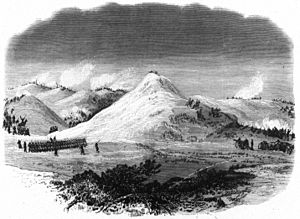Battle of Wolf Mountain facts for kids
Quick facts for kids Battle of Wolf Mountain |
|||||||
|---|---|---|---|---|---|---|---|
| Part of the Great Sioux War of 1876 | |||||||
 A photoprint of an illustration of the Battle of Wolf Mountain that appeared in the May 5, 1877 edition of Frank Leslie's Illustrated Newspaper |
|||||||
|
|||||||
| Belligerents | |||||||
| Sioux Cheyenne |
|||||||
| Commanders and leaders | |||||||
| Crazy Horse Two Moon |
|||||||
| Strength | |||||||
| 436 | ~500 | ||||||
| Casualties and losses | |||||||
| 3 killed 8 wounded |
3 killed Unknown wounded |
||||||
The Battle of Wolf Mountain was a fight that happened on January 8, 1877. It was part of the Great Sioux War of 1876. Soldiers from the United States Army fought against Lakota Sioux and Northern Cheyenne warriors. The battle took place in southern Montana Territory, near the Tongue River. Today, this area is about four miles southwest of Birney, Montana.
In 2001, the place where the battle happened, called the Wolf Mountains Battlefield, was recognized as a special historical site. It became a National Historic Landmark in 2008.
Contents
Why Did the Battle of Wolf Mountain Happen?
After Lieutenant Colonel George A. Custer's defeat in the Battle of the Little Bighorn in June 1876, the U.S. government sent many more soldiers to Montana. As winter approached, some Sioux and Cheyenne groups started going back to their reservations. They needed food and supplies for the cold months.
However, the United States Congress had made many Native Americans angry. They demanded that the tribes give up the Black Hills land in exchange for these supplies. Also, the army had taken over managing the reservations. This made many warrior groups decide to stay away.
General Nelson A. Miles led a group of soldiers, including infantry (foot soldiers), artillery (cannons), and cavalry (soldiers on horseback). He went after Sitting Bull's group and largely defeated them by December. Another general, Ranald S. Mackenzie, had also defeated Dull Knife's Cheyenne group. Dull Knife's people traveled through snow and ice to join Crazy Horse's camp in the Tongue River Valley.
Crazy Horse was worried about the coming winter and how difficult things were for Dull Knife's group. He decided to try and make peace with the army. But after a conflict involving United States Army Crow scouts, Crazy Horse felt he needed to fight back. He led small attacks to try and get Colonel Miles to leave Tongue River Cantonment.
In December 1876, Colonel Miles led about nine companies of infantry out of the Cantonment. They marched south, following the Tongue River valley, to find Crazy Horse. On January 7, 1877, Miles captured some Northern Cheyennes. His force of 436 men then camped along the Tongue River, just south of where Birney, Montana, is today. That night, a lot of fresh snow fell, and the temperature dropped very low.
What Happened During the Battle?
Shots were fired early in the morning. Colonel Miles quickly set up a strong defense along a ridge. The most important spot on this ridge was a small, cone-shaped hill later called Battle Butte. Miles placed two cannons next to it, giving them a clear view to fire.
At 7:00 AM, Crazy Horse and Two Moon began attacking the soldiers. The warriors found it hard to get past the army's strong firepower. They regrouped several times to try new attacks. They also tried to go around the sides of Miles's line, but Miles moved his extra soldiers to block them.
Finally, Miles ordered several companies of his 5th Infantry to move forward. They were to take over a series of hills where the warriors were hiding. Miles's soldiers had a tough time climbing the hills, especially with the deep snow. After the soldiers managed to capture seven of these hills, the Sioux and Cheyenne warriors started to leave. The weather was getting worse, which also made them pull back. The battle ended without a clear winner on the battlefield itself.
What Was the Result of the Battle?
Even though the battle didn't have a clear winner right away, it was a big win for the U.S. Army in the long run. It showed the Sioux and Cheyenne that they were not safe from the army, even during the harsh winter. This made many individuals and groups decide to leave the fight and go back to their reservations. By May, Crazy Horse had led his remaining group to Camp Robinson to give up.
Who Fought in the Battle?
United States Army
(Colonel Nelson A. Miles, in charge)
- 5th U.S. Infantry Regiment
- Company A
- Company C
- Company D
- Company E
- Company K
- Company B detachment
- Company H detachment
- 22nd U.S. Infantry Regiment: Lieutenant Colonel Elwell S. Otis
- Company E
- Company F
Native Americans
Lakota Sioux and Northern Cheyenne. (Led by Crazy Horse and Two Moon)
- About 500 warriors
See also
 In Spanish: Batalla de Wolf Mountain para niños
In Spanish: Batalla de Wolf Mountain para niños

